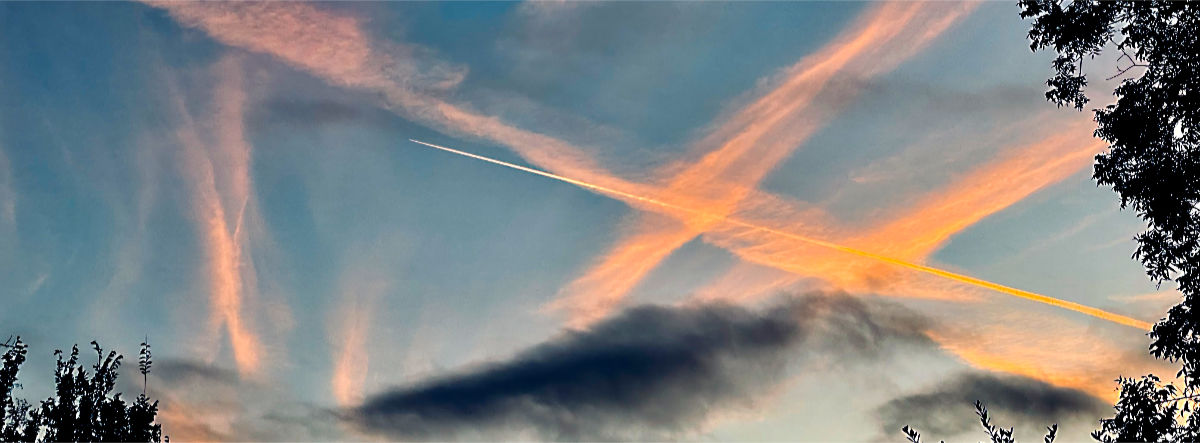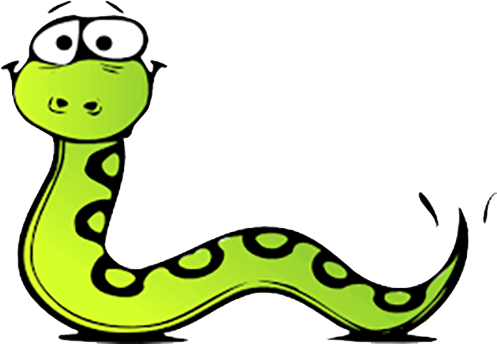
It won’t surprise you in the least to learn that I’m a member of a number of OIGs (Organism Identification Groups) on Facebook. I rely on these groups to help me identify and learn more about the plants, insects, lizards, turtles, and — yes — snakes that I come across, either in person or online. I’ve found the administrators of these groups to be extremely helpful and eager to educate folks like me who often know just enough to be dangerous (either to themselves or others or to the creatures being discussed).
Last week, a post from one of these groups came across my Facebook feed. The post consisted of a photo that was lifted from yet another group, and it immediately captured my attention. Here ’tis:
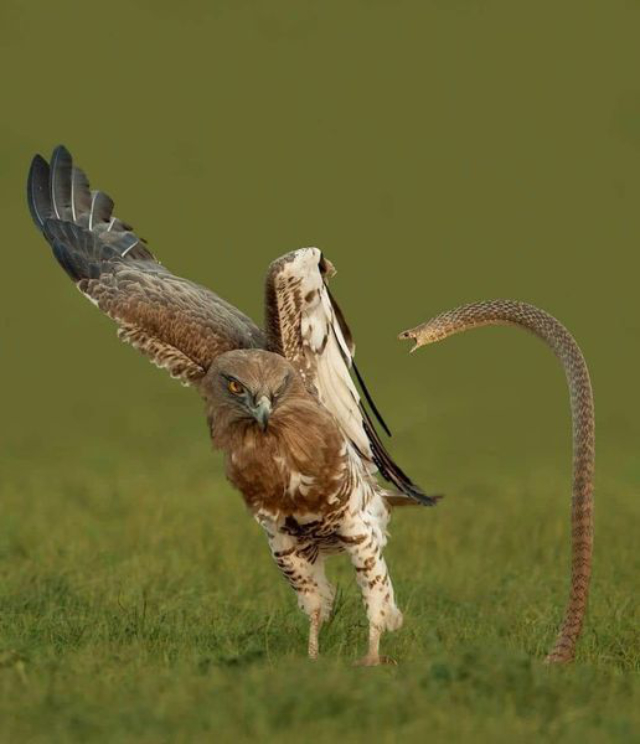
In a display of entirely unwarranted certainty, I immediately identified the bird as a red-tailed hawk, and the snake as a western coachwhip, albeit one that exhibited a couple of characteristics and a behavior that seemed a bit…off.
I posted this photo to my primary go-to serpent I.D. page — the Central Texas Snake Identification group, and asked if (1) my initial identifications were right [they weren’t] and (2) if the snake’s posture appears to be a common behavior [still an open question].
As it turns out, the bird is a Short-toed snake eagle (Circaetus gallicus), and the snake is an Indian rat snake (Ptyas mucosa). The eagle is an Afro-Eurasia species, and not found naturally in the western hemisphere. The snake, despite its name, is not limited to India but is found throughout Asia.
All of that is semi-interesting — less so because the photo doesn’t depict any creatures I’ll ever encounter outside a zoo — but it’s not the focus (no pun intended, as you’ll see in a minute) of this post.
The more I looked at the photo, the more questions I had. As I mentioned above, something looked a bit not-right. My skepticism was strengthened when a few people in the snake I.D. group questioned its reality. The first person to comment in that manner mentioned the odd depth of field of the photo. The foreground looks OK, but the background fades quickly into the sort of flat uniformity that just isn’t right.
Then, someone else mentioned that the snake looked like it was added into the photo. These observations were sufficient to cause me to do some further investigation.
Since the original photo had no attribution, I did a reverse image search. I first uploaded the photo to Tineye, which purports to match a given picture to more than 60 billion others to determine its provenance. That service found no matches.
I then went to Google’s image search service, Google Lens, and had much better luck. Not only did it find other places where this photo had been uploaded, such as Pinterest, it more helpfully provided a slew of closely related scenes, some of which were obviously more reliable than the unattributed version uploaded to a random Facebook page.
In fact, I think I found the original image from which the above photo was derived. Take a look here (click on the photo to see a full-sized version):
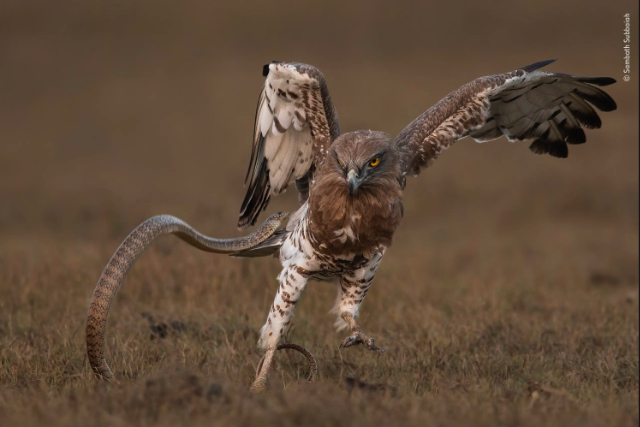
Sambath Subbaiah was recognized as Wildlife Photographer of the Year award in the Birds Behaviour category, sponsored by the London Natural History Museum. You can learn more via this page, where I found this photo.
Now, just because I found a better photo of this scene doesn’t necessarily prove that the first photo was manipulated. After all, it could have just been another shot from the same sequence of events. So, I tried to compare the two photos to see if there was further evidence.
I started by flipping the first photo horizontally to match what I’ll call the master photo. I then resized the two to approximately the same dimensions and composited them into the following side-by-side image (again, click for a larger version):
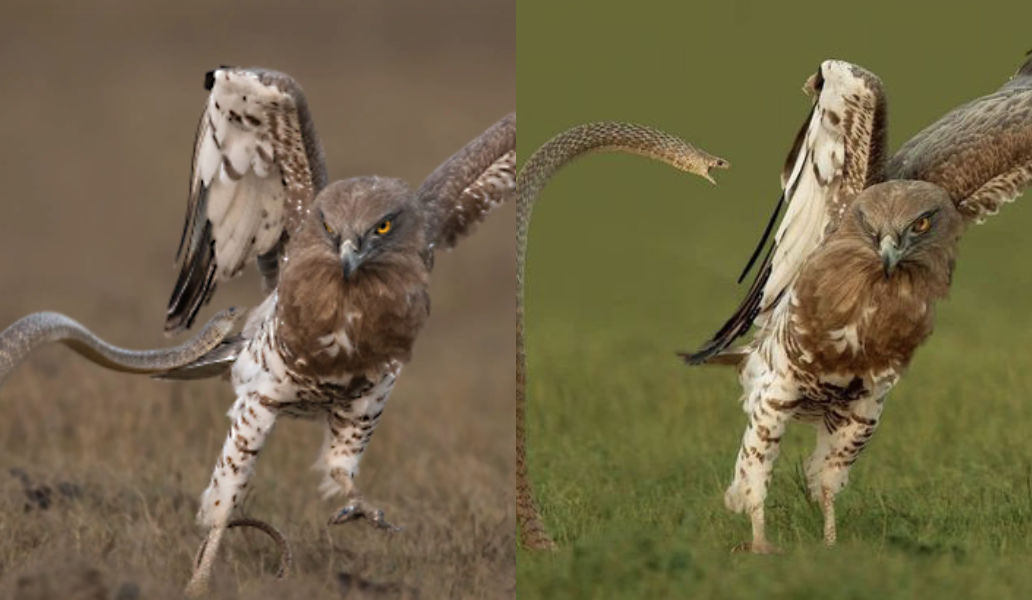
Look closely at the eagle’s right leg (the left one as you view the photo). The markings are identical in both photos, so it’s the same bird. Also, the bird’s head position and expression are identical, so the photo on the right must have been taken from the master photo.
The scene on the right begins to unravel when we inspect the bird’s wing closest to the snake. It’s been warped inward toward the bird’s body in a very unnatural way, and the warp effect also distorts the other wing as well as the bird’s body. There’s also the unnatural blurring of the background, evidence of manipulation. And, as mentioned above, the snake just isn’t right.
So, you may be thinking, why does this matter? Fair question. I’m not trying to imply that a “bad actor” is responsible for the manipulation…that there’s any ill intent on the part of whoever created the copy of the original photo. It could be that someone was simply trying to amp up the drama of the original. And maybe they just like playing around with Photoshop or similar programs, and never intended for this to be released “into the wild.” But from my perspective, there are three issues.
First, with the increasing use of artificial intelligence to create and/or manipulate photos, videos, and even speech, it’s more important than ever to seek to discern the real from the fake. We’re at the point now where it’s appropriate to question everything we see online, even if the subject is completely innocuous and the answer to the question is unimportant.
Second, and more important to me is the use/misuse of copyrighted material. I’m actually walking a fine line myself with this post by including the original photo, even with attribution. I would hope that my attempt to secure proper attribution for Mr. Subbaiah’s excellent work will be a suitable defense, but if he insists that I remove this post, I will do so in a heartbeat. Regardless, I have been the victim of people “borrowing” my photos for commercial use without asking permission or giving attribution, and I didn’t appreciate it. (On those occasions where someone asked permission in advance, I have never refused the request.)
The last issue is perhaps the least important, but it matters to me. When a dramatic moment in nature is captured, as Mr. Subbaiah has done with his photo, the purity and realism does not need any additional enhancement. Nothing is gained by making the snake appear more threatening, for example. In other words, Nature is cool and dramatic enough on its own…it doesn’t need our help.
Discover more from The Fire Ant Gazette
Subscribe to get the latest posts sent to your email.

